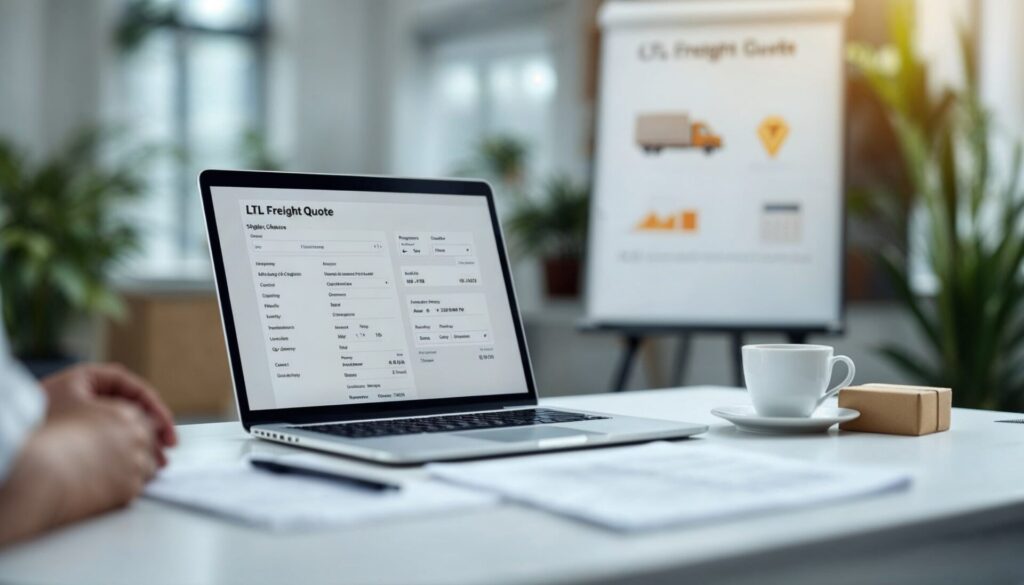
Step-by-Step: Getting an LTL Freight Quote
Navigating Less Than Truckload (LTL) shipping can feel like driving through a winding road with occasional blind curves: you think you have everything in place until you run into an unexpected fee or a reclassification. One of the most effective ways to avoid those pitfalls is to secure a precise freight quote in advance. By carefully following the right steps—such as measuring your shipment accurately, selecting a reputable carrier, and clarifying your requirements—you can secure a quote that aligns with your budget and timeline.
In this detailed guide, we’ll walk you through each step of the LTL quote process, demystify the jargon, and equip you with practical tips to ensure you’re never caught off-guard. Whether you’re a small-business owner new to shipping or a seasoned logistics manager fine-tuning your operations, understanding these steps will put you ahead in securing accurate quotes and smoother deliveries.
Introduction to LTL Freight Quotes
Why Accurate Quotes Are Crucial
Imagine budgeting for a large shipment, only to discover that the final invoice is hundreds—if not thousands—of dollars more than expected. LTL quotes, when done correctly, serve as your financial compass, helping you anticipate potential shipping costs and plan your business finances responsibly. An accurate quote can be the difference between profitable shipments and unexpected losses.
- Budget Certainty: You’ll know the approximate cost beforehand, making it easier to set product prices or negotiate with customers.
- Reduced Risk: If your weight or freight class is off, you risk a reweigh or reclassification, both of which lead to added fees.
- Operational Efficiency: With quotes in hand, your shipping schedule becomes more predictable, allowing you to meet deadlines smoothly.
Common Misconceptions About LTL Pricing
- “Cheapest Is Best”: Opting for the lowest rate can backfire if you don’t factor in transit times, reliability, or potential hidden charges.
- “All Carriers Use the Same Calculation”: Different carriers employ varying methods to calculate rates, including unique base rates, zones, and discount structures.
Understanding how quotes are generated will save you from unexpected costs and late shipments—two major headaches in the logistics world.
Key Terminology You Should Know
Before diving into the step-by-step process, it helps to familiarize yourself with the common terms you’ll encounter.
Freight Class and NMFC Codes
- Freight Class: A standard system that categorizes shipments based on density, stowability, handling, and liability. Classes range from 50 to 500, with lower numbers generally indicating denser, less-valuable goods.
- NMFC (National Motor Freight Classification): A code assigned to specific types of goods. You’ll often need this code for your Bill of Lading and for obtaining accurate quotes.
Accessorials, Fuel Surcharges, and More
- Accessorials: Extra fees for services such as liftgate usage, residential delivery, or inside delivery.
- Fuel Surcharge: A variable fee carriers use to offset fluctuations in fuel prices.
- Declared Value: An additional cost to increase the carrier’s liability for high-value freight.
Grasping these terms will help you decode what’s behind each line item on a quote so you can better manage your shipping expenses.
Step 1: Clarify Your Shipment Details
Determining Dimensions and Weight
Accuracy starts with basic math—literally. LTL carriers will base a significant part of your quote on the shipment’s weight and volume:
- Length, Width, Height: Measure your freight down to the inch, including pallets or crates.
- Scale Weight: Weigh your freight on a reliable scale. If you ship frequently, consider investing in a freight scale to avoid guesswork.
- Packaging Materials: Pallets, bubble wrap, crates—all add weight and affect dimensions. Don’t exclude them from your final calculations.
Identifying Special Handling Requirements
Does your cargo include fragile glassware? Electronics that require specialized packing? Hazardous materials needing special labeling? Identifying such details up front is crucial for an accurate quote. Extra requirements often lead to additional fees, but they also prevent damage and help the carrier plan effectively.
Step 2: Research Potential Carriers and Brokers
Carrier vs. Broker vs. 3PL
- Carriers: Companies like FedEx Freight, UPS Freight, or regional operators that physically transport your goods.
- Freight Brokers: Intermediaries who shop around on your behalf, often leveraging high volume to secure better rates.
- 3PL (Third-Party Logistics Provider): Full-scale logistics companies that can handle everything from storage to shipping across multiple carriers.
Choosing the right partner depends on your volume, shipping lanes, and need for extra services like warehousing or order fulfillment. While direct carrier relationships can be straightforward, brokers and 3PLs can save time and potentially secure lower rates if you don’t have the leverage of a high shipping volume.
Reputation, Coverage, and Service Offerings
- Reliability: Check online reviews or talk to other businesses in your network. A lower rate is worthless if your deliveries are chronically late.
- Coverage: Ensure the carrier or broker serves both your pickup and delivery locations.
- Service Options: Confirm they provide any special services you might need, such as cross-border shipping or refrigerated freight.
By narrowing your choices based on reliability and coverage, you’ll already be a step ahead when requesting quotes.

Step 3: Gather and Verify Freight Class
Understanding the Role of Density
Freight class is partly determined by density—how heavy your shipment is relative to its size. More compact, heavier shipments generally fall into a lower (and cheaper) freight class, while bulky, lightweight items may skyrocket to higher classes.
- Calculate Density:
Density (lbs/ft³) = (Weight of Freight in lbs) ÷ [(Length in inches × Width in inches × Height in inches) ÷ 1728]
(There are 1,728 cubic inches in a cubic foot.) - Match to Class: Refer to the NMFC guide or online charts to see if your density corresponds to a class range.
Common Errors in Classification
- Overlooking Packaging Size: Always include pallet dimensions.
- Mislabeling Product Type: If your goods are fragile but you mark them as a lower class, expect the carrier to reclassify.
- Not Updating Class for Mixed Shipments: Different items on a single pallet may have varying classes.
Accurately determining your freight class helps you avoid reclassification fees, which can be both costly and time-consuming to correct.
Step 4: Decide on Pickup and Delivery Services
Residential vs. Commercial Locations
The type of delivery location significantly influences your quote:
- Commercial Address with a Dock: Typically the cheapest and simplest, since no extra equipment is needed.
- Residential Address: Usually incurs additional fees for limited access, the use of liftgates, and more precise scheduling.
- Construction Site or Farm: Often falls under “limited access” and may trigger higher costs or special instructions.
Identify your pickup and drop-off locations clearly. If in doubt, ask your carrier or broker what classification your site falls under.
Liftgate, Inside Delivery, and Appointment Windows
- Liftgate: Required when loading docks or forklifts aren’t available.
- Inside Delivery: The driver carries freight beyond the loading dock or doorstep.
- Appointment Windows: Some sites require a set delivery time. This can add to your bill, but it also prevents missed deliveries and rescheduling hassles.
Each of these services typically comes with its own accessorial fee, so note them in your quote request.
Step 5: Requesting an LTL Freight Quote
Using Online Platforms and Tools
Most carriers and brokers now offer digital portals where you can input shipment details to get an instant or near-instant quote. These platforms:
- Save Time: No phone tag or lengthy emails.
- Provide Transparency: See a breakdown of base rates, fuel surcharges, and accessorial fees.
- Offer Multiple Options: Some portals compare rates across different carriers, letting you choose the best fit for your needs.
If you prefer a tech-driven approach, consider using a Transportation Management System (TMS) that integrates with multiple carrier APIs to automate quoting and booking.
Phone and Email Requests
If your shipment is more complex—say it involves hazmat materials, oversized items, or special handling—picking up the phone or sending a detailed email may be more effective. You can talk directly to a representative who can tailor the quote to your specific situation. Even in today’s digital era, direct communication can uncover hidden discounts or service perks you might not see online.
Step 6: Comparing Multiple Quotes
Evaluating Rate Differences
LTL quotes can vary widely due to:
- Base Rate Discrepancies: Each carrier sets its own baseline.
- Discount Structures: Large volume shippers might get steeper discounts.
- Route Optimization: A carrier might offer lower rates for routes it frequently serves, while charging more for less-traveled lanes.
Avoid fixating on the lowest number. Consider the overall value, factoring in reliability, insurance options, and transit time.
Factoring in Transit Time and Reliability
A super-cheap quote is worthless if your shipment arrives late or damaged. Check the carrier’s historical performance. Some might promise a quick delivery window but have higher damage claims. Balancing cost and quality is key—especially if you have tight deadlines or fragile goods.
Step 7: Understanding Accessorial Fees
Common Extra Charges
- Reweigh / Reclassification: If your declared weight or class is off.
- Fuel Surcharge: Tied to fluctuating diesel prices.
- Residential or Limited Access: For non-commercial addresses.
- Detention Charges: If loading or unloading takes too long.
Knowing these charges ahead of time helps you see the “all-in” cost of shipping, so you’re not blindsided when the invoice arrives.
How to Avoid Unnecessary Costs
- Accurate Weight and Dimensions: The more precise you are, the less likely you’ll face reweigh fees.
- Efficient Loading: If you’re responsible for loading, have everything ready to go. Delays can lead to detention charges.
- Plan Pickup/Delivery Windows Carefully: If your site has restricted hours, communicate that early to avoid redelivery fees or missed appointments.

Step 8: Reviewing Terms and Conditions
Liability Coverage and Cargo Insurance
Most carriers offer limited liability—often just a set dollar value per pound. High-value items like electronics or specialty goods might require additional coverage. If your goods are worth significantly more than standard coverage allows, look into purchasing third-party cargo insurance. The cost might be well worth the peace of mind.
Payment and Billing Arrangements
- Prepaid: Shipper pays the freight charges up front.
- Collect: Receiver pays upon delivery.
- Third-Party Billing: Someone else, like a 3PL, handles the transaction.
Clarify these terms before booking. Also, confirm when payments are due—some carriers offer 15- to 30-day terms, while others require immediate or credit-card-based billing.
Step 9: Confirming the Shipment
Preparing a Proper Bill of Lading (BOL)
The Bill of Lading is your contract with the carrier. It lists:
- Shipper and Receiver Info
- Freight Class and NMFC
- Weight and Dimensions
- Special Instructions or Accessorial Services
Always double-check the BOL’s accuracy before the driver arrives. Any mismatch between the BOL and the carrier’s evaluation can lead to extra charges or delayed shipping.
Scheduling Your Pickup Window
Carriers typically provide a pickup window rather than a fixed time. Have your freight ready to go—palletized, labeled, and staged—in case the driver arrives early. If you can’t meet that window, contact the carrier as soon as possible to reschedule. Last-minute changes can result in a higher bill or missed pickup slots.
Step 10: Ensuring Accurate Documentation
Double-Checking Labels and Paperwork
- Labels: Each pallet or box should be labeled with the origin, destination, and any special handling instructions.
- Proof of Delivery (POD): At the receiving end, someone must sign the POD, which verifies the item arrived and in what condition.
- International Shipments: If you’re crossing borders, factor in customs documentation, commercial invoices, and other legal paperwork.
Proper documentation speeds up the process, reduces errors, and provides clear evidence if something goes wrong.
Communicating with Drivers and Dispatchers
If the shipment is time-sensitive, maintain an open line of communication. Some carriers have dispatchers who can update you on the driver’s ETA. Providing a direct phone number for the pickup or delivery site ensures drivers can resolve access issues quickly, minimizing delays.
Post-Quote Considerations and Best Practices
Tracking and Monitoring Your Shipment
Modern carriers often offer real-time tracking portals or mobile apps. Monitoring your freight in real-time allows you to:
- Spot Potential Delays: Traffic, weather, or mechanical breakdowns can cause unexpected holdups.
- Update Customers: A quick email or text to let them know the new ETA fosters trust and transparency.
Stay proactive. If you see a delay, contact the carrier to learn about potential rerouting or expedited options.
Filing Claims and Handling Disputes
Despite best efforts, damage or loss can still occur. Familiarize yourself with the claims process for your chosen carrier:
- Document Everything: Take photos before shipping, note any visible damage upon delivery.
- File Claims Promptly: Many carriers have strict deadlines—sometimes as short as 5 to 15 days after delivery.
- Maintain Open Communication: Let your carrier know you’re initiating a claim; they can guide you on the next steps.
Being prepared helps you protect your financial interests and maintain strong relationships with customers and carriers.
Conclusion
Securing an accurate LTL freight quote isn’t rocket science, but it does demand attention to detail. Each step—measuring your shipment, understanding your freight class, deciding on necessary services, and choosing a reliable carrier—directly influences your final cost and delivery outcome. By following this comprehensive guide, you can skip the trial-and-error phase and move straight into efficiently managing your logistics.
From the moment you start gathering dimensions to the day your shipment reaches its final destination, a well-managed LTL quote process serves as your backbone. It helps you budget effectively, avoid hidden fees, and foster better relationships with carriers, customers, and suppliers. The up-front work pays off in fewer invoice surprises, smoother shipping, and a more agile supply chain.
Remember: the key to a great LTL shipping experience lies in transparency and communication. Provide your carrier or broker with complete, accurate information right away—this single step alone slashes the risk of unexpected costs and delays. With each shipment, you’ll refine your approach until requesting LTL quotes becomes second nature. And that confidence will shine through in your business’s improved efficiency and customer satisfaction.
How useful was this post?
Click on a star to rate it!
Average rating 0 / 5. Vote count: 0
No votes so far! Be the first to rate this post.



